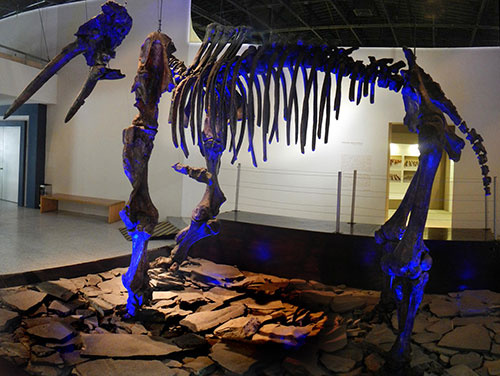|

By John Pint
We were strolling along the Malecón
of Ajijic, Mexico, with new friends. One of them gazed at the placid
waters with dreamy eyes and began to tell us stories of amazing animals
with exotic names like Megatherium and Gomphothere, creatures which
used to frolic alongside the lake in prehistoric times.
“A
couple of them got stuck in the mud here... and you should have seen
how my father's eyes lit up when he found their bones back in 2000.”
Well, the speaker turned out to be Diana Solórzano, former Director of
Guadalajara's Museo de Paleontologia and daughter of Jalisco's most
famous expert in Paleontology, Federico A. Solórzano, indefatigable
collector of ancient bones and founder of the museum.
 On
discovering that we had never visited the museum, which is located at
the east end of Agua Azul park in Guadalajara, Diana immediately
offered to give us a special tour of the place and a week later we met
her in front of the impressive skeleton of that very Gomphothere her
father had excavated from the lakeside 15 years before. This
elephant-like creature stood 2.5 meters tall, weighed 6,000 kilos and
had curved tusks about 3.5 meters long. It roamed western Mexico 13,000
years ago and is a suitable symbol for the Paleontology Museum, which,
by the way, took second place in a poll conducted by the magazine
México Desconocido for “Best Cultural Attraction in Guadalajara.” Of
course, the famous Hospicio Cabañas came in first, but if I had known
how interesting choice number two was, I would have checked it out long
ago. On
discovering that we had never visited the museum, which is located at
the east end of Agua Azul park in Guadalajara, Diana immediately
offered to give us a special tour of the place and a week later we met
her in front of the impressive skeleton of that very Gomphothere her
father had excavated from the lakeside 15 years before. This
elephant-like creature stood 2.5 meters tall, weighed 6,000 kilos and
had curved tusks about 3.5 meters long. It roamed western Mexico 13,000
years ago and is a suitable symbol for the Paleontology Museum, which,
by the way, took second place in a poll conducted by the magazine
México Desconocido for “Best Cultural Attraction in Guadalajara.” Of
course, the famous Hospicio Cabañas came in first, but if I had known
how interesting choice number two was, I would have checked it out long
ago.
Federico Solórzano was born in 1922 and developed a yen for
bone collecting when he was just eight years old. “Every one of them
has a story to tell,” he would later say, “and believe it or not, they
speak to me.” He studied Pharmaceutical Chemistry and Biology, but
fossils were always his true love and he became a self-taught
paleontologist. Over the years, his private collection grew and grew
and finally—rather than hording his treasures for himself—he chose to
share them with anyone interested in western Mexico's fascinating past.
Want
to discover this ancient world? Just step into the museum. Here you'll
find the sabre-toothed cat which went extinct 10,000 years ago and
whose remains have only been found in North and South America. Take a
few steps and find yourself face-to-face with a
capybara, a
fuzzy, adorable-looking creature whose modern-days descendants are
still the world's largest rodents, weighing up to 66 kilos. In
Pleistocene times they were lots bigger and frolicked around Lake
Chapala in great numbers.
Amble on and you'll discover a mammoth
tooth as big as a beach ball with a table telling you how to determine
the age of a mammoth by looking at its molars.
But not all these fossils are gigantic. One of the most fascinating of
all is the teeny skeleton of Tapatia
occidentalis,
a little live-bearing, sweet-water fish less than 20 milimeters (0.79
inches) long which once lived near Amatitán in what is now the Santa
Rosa Canyon. This extinct fish which was given such a charming name,
happens to be a relative of Ameca splendens,
a native of the Teuchitlán River and, itself, now in danger of
extinction.
As
you move through the museum, you discover that Federico Solórzano was
also fascinated by geology. His collection of minerals is mind-boggling
and even includes several genuine meteorites, older than the earth
itself.
Perhaps the most educational exhibit in the whole museum
is The Bridge, which takes you above a simulated sandy plain dotted
with skeletons and bones which visitors are challenged to identify.
There's even an “on-going” archaeologist's dig where you can learn
about the painstaking process of excavating and documenting bones or
artifacts in situ.
At the end of
your tour of the museum, a wonderful surprise awaits you: a temporary
exhibit (opened November 1, 2014) of pure fantasy entitled Fantasía
Prehistórica II. This room is peopled with over 50 strange and
enchanting beings created by artist and poet Alberto Meillón. Having
looked at so many skeletons in the museum, we suddenly find whimsical
creatures made of everything from fishbones and seashells to flotsam
and jetsam. Here you will cross paths with the improbably long-legged
Queloniodon, the fearsome Scorpionis tenax and the world's only fossil
of the utterly bizarre Kandinskysaurus. If this exhibit turns on your
creative juices, in the last room of the museum you yourself can become
the creator of a new being the world has never seen before. Just put
together the magnetic wings and body parts of your choice and snap a
selfie of you and your new creation.
The Museo
de Paleontología Federico A. Solórzano Barreto
is open Tuesday to Saturday from 10:00 AM to 6:00 PM and Sundays from
11 to 4. It's located at Roberto Michel 520 at the corner of González
Gallo, Tel 36 19 55 60 and 36 19 70 43. Admission is 20 pesos, but it's
free for anyone over 60 or under 12.
|

